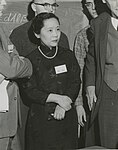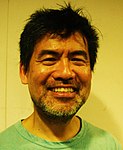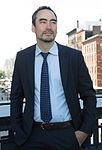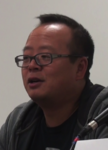
American Chinese cuisine is a style of Chinese cuisine developed by Chinese Americans. The dishes served in many North American Chinese restaurants are adapted to American tastes and often differ significantly from those found in China.

Manhattan's Chinatown is a neighborhood in Lower Manhattan, New York City, bordering the Lower East Side to its east, Little Italy to its north, Civic Center to its south, and Tribeca to its west. With an estimated population of 90,000 to 100,000 people, Chinatown is home to the highest concentration of Chinese people in the Western Hemisphere. Manhattan's Chinatown is also one of the oldest Chinese ethnic enclaves. The Manhattan Chinatown is one of nine Chinatown neighborhoods in New York City, as well as one of twelve in the New York metropolitan area, which contains the largest ethnic Chinese population outside of Asia, comprising an estimated 893,697 uniracial individuals as of 2017.

Flushing is a neighborhood in the north-central portion of the New York City borough of Queens. The neighborhood is the fourth-largest central business district in New York City. Downtown Flushing, a major commercial and retail area centered around the intersection of Main Street and Roosevelt Avenue, is the third-busiest intersection in New York City, behind Times and Herald Squares.

Bensonhurst is a residential neighborhood in the southwestern section of the New York City borough of Brooklyn. The neighborhood is bordered on the northwest by 14th Avenue, on the northeast by 65th Street, on the southeast by Avenue P and 22nd Avenue, and on the southwest by 86th Street. It is adjacent to the neighborhoods of Dyker Heights to the northwest, Borough Park and Mapleton to the northeast, Bath Beach to the southwest, and Gravesend to the southeast.
This article discusses Chinatowns in the Americas. The regions include: Canada, the United States, and Latin America.

Cantonese is a variety of Chinese originating from the city of Guangzhou and its surrounding area in Southeastern China. It is the traditional prestige variety of the Yue Chinese dialect group, which has about 68 million native speakers. While the term Cantonese specifically refers to the prestige variety, it is often used to refer to the entire Yue subgroup of Chinese, including related but largely mutually unintelligible languages and dialects such as Taishanese.

New York City's demographics show that it is a large and ethnically diverse metropolis. It is the largest city in the United States with a long history of international immigration. New York City was home to over 8.3 million people in 2019, accounting for over 40% of the population of New York State and a slightly lower percentage of the New York metropolitan area, home to approximately 23.6 million. Over the last decade the city has been growing faster than the region. The New York region continues to be by far the leading metropolitan gateway for legal immigrants admitted into the United States.

Mott Street is a narrow but busy thoroughfare that runs in a north–south direction in the New York City borough of Manhattan. It is regarded as Chinatown's unofficial "Main Street". Mott Street runs from Bleecker Street in the north to Chatham Square in the south. It is a one-way street with southbound-running vehicular traffic only.

Two Bridges is a neighborhood in the New York City borough of Manhattan, nestled at the southern end of the Lower East Side and Chinatown on the East River waterfront, near the footings of the Brooklyn Bridge and Manhattan Bridge. The neighborhood has been considered to be a part of the Lower East Side for much of its history. Two Bridges has traditionally been an immigrant neighborhood, previously populated by immigrants from Europe, and more recently from Latin America and China. The Two Bridges Historic District was listed in the National Register of Historic Places in September 2003.

Little Fuzhou, or Fuzhou Town, is a neighborhood in the Two Bridges and Lower East Side areas of the borough of Manhattan in New York City. Starting in the 1980s and especially in the 1990s, the neighborhood became a prime destination for immigrants from Fuzhou, Fujian, China. Manhattan's Little Fuzhou is centered on East Broadway. However, since the 2000s, Chinatown in the neighborhood of Sunset Park became New York City's new primary destination for the Fuzhou immigrants, surpassing the original enclave in Manhattan.

Since its founding in 1625 by Dutch traders as New Amsterdam, New York City has been a major destination for immigrants of many nationalities who have formed ethnic enclaves, neighborhoods dominated by one ethnicity. Freed African American slaves also moved to New York City in the Great Migration and the later Second Great Migration and formed ethnic enclaves. These neighborhoods are set apart from the main city by differences such as food, goods for sale, or even language. Ethnic enclaves provide inhabitants security in work and social opportunities, but limit economic opportunities, do not encourage the development of English speaking, and keep immigrants in their own culture.

Eighth Avenue is a major street in Brooklyn, New York City. It was formerly an enclave for Norwegians and Norwegian-Americans, who have recently become a minority in the area among the current residents, which include new immigrant colonies, among them Chinese and Arab-speaking peoples. Parts of it have been colloquially re-christened Little Hong Kong in recognition of these newer communities.

Avenue U is a street located in Brooklyn, New York, United States. This avenue is a main thoroughfare throughout its length. Avenue U begins at Stillwell Avenue in Gravesend and ends at Bergen Avenue in Bergen Beach, while serving the other Brooklyn neighborhoods of Gravesend, Homecrest, Sheepshead Bay, Marine Park, and Mill Basin along its route.

The first Brooklyn Chinatown, was originally established in the Sunset Park area of the New York City borough of Brooklyn. It is one of the largest and fastest growing ethnic Chinese enclaves outside of Asia, as well as within New York City itself. As this Chinatown is rapidly evolving into an enclave predominantly of Fuzhou immigrants from Fujian Province in China, it is now increasingly common to refer to it as the Little Fuzhou or Fuzhou Town of the Western Hemisphere; as well as the largest Fuzhou enclave of New York City.
This article contains a list of the Chinatowns, which are either officially designated neighborhoods or historically important, in the United States. Historically speaking, many of these Chinatowns were formed in the 1800s Chinese diaspora and have served as ethnic Chinese enclaves.
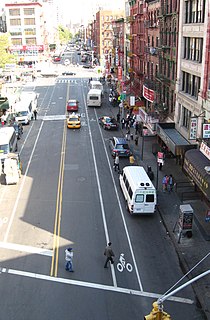
East Broadway is a two-way east–west street in the Chinatown, Two Bridges, and Lower East Side neighborhoods of the New York City borough of Manhattan.

As of the 2011 American Community Survey, New York City is home to 100,000 ethnic Koreans, with two-thirds living in the borough of Queens. On the other hand, the overall Greater New York Combined Statistical Area enumerated 218,764 Korean American residents as of the 2010 United States Census, the second-largest population of Koreans outside of Korea and the most prominent.

There are multiple Chinatowns in the borough of Queens in New York City. The original Queens Chinatown emerged in Flushing, initially as a satellite of the original Manhattan Chinatown, before evolving its own identity, surpassing in scale the original Manhattan Chinatown, and subsequently in turn spawning its own satellite Chinatowns in Elmhurst, Corona, and eastern Queens.
Fuzhounese Americans, also known as Hokchew Americans or Fuzhou Americans or imprecisely Fujianese, are Chinese American people of Fuzhou descent, in particular from Changle, Fujian Province, People's Republic of China. Many Chinese restaurant workers in the United States are from Fuzhou. There are also a number of undocumented Fuzhounese immigrants in the United States who are smuggled in by organizations like the Snakeheads. Fuzhounese Americans also helped develop the Chinatown bus lines system, which originated as a means to transport restaurant workers from New York City to various parts of the northeastern United States. Fuzhounese Americans are almost singularly concentrated in the U.S. Northeast, unlike other Chinese Americans and Asian American groups; with the vast majority in New York City and on Long Island, but also in Middlesex and Morris counties in New Jersey and in the Boston and Philadelphia metropolitan areas.

















